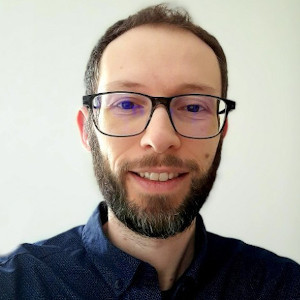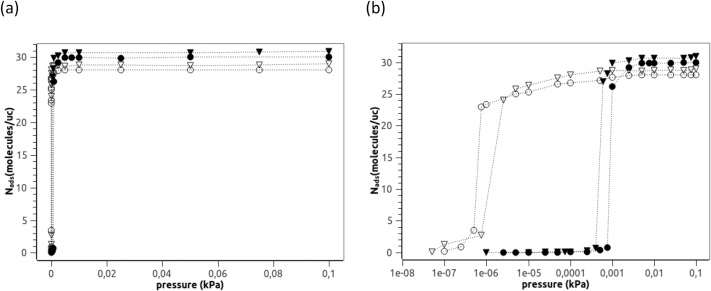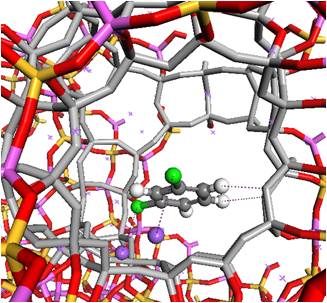Multi-scale numerical simulations
Scientific objectives
- Microscopic interpretation of experimental observations
- “In-silico” materials characterization
- Numerical prediction of materials properties
Members
Research fields

2D crystals (silicene, germanene…) : electronic structure and functionalization
R. Stephan, M.-C. Hanf, Ph. Sonnet*
*Contact : philippe.sonnet@uha.fr
Our studies are devoted to the structural and electronic properties of supported silicene and germanene, particularly of their interface with a substrate. The aim is the electronic 2D crystal decoupling from the support, for an analysis of its intrinsic properties. We also performed the first chemisorption (cycloaddition) studies on supported silicene for organic molecules of various sizes.

Publications :
M.-C. Hanf, D. Sciacca, R. Bernard, Y. Borensztein, A. Resta, Y. Garreau, A. Vlad, A. Coati, I. Lefebvre, M. Derivaz, C. Pirri, P. Sonnet, R. Stephan, and G. Prévot Phys. Rev. B 106, 045412 2022 DOI : 10.1103/PhysRevB.106.045412
K. Zhang, D. Sciacca, M.-C. Hanf, R. Bernard, Y. Borensztein, A. Resta, Y. Garreau, A. Vlad, A. Coati, I. Lefebvre, M. Derivaz, C. Pirri, P. Sonnet, R. Stephan, and G. Prévot Phys. Chem. C, 125 (44) 24702–24709 2021 DOI :10.1021/acs.jpcc.1c07585
MC Hanf, A Marjaoui, R Stephan, M Zanouni, M Diani, P Sonnet J. Phys. : Condens. Matter 32 195503 2020 DOI : 10.1088/1361-648X/ab6ae8
N. Massara, A. Marjaoui, R. Stephan, M-C Hanf, M. Derivaz, D. Dentel, S. Hajjar-Garreau, A. Mehdaoui, M. Diani, P. Sonnet and C. Pirri 2D Mater. 6 035016 2019 DOI : 10.1088/2053-1583/ab1601
R. Stephan, M. Derivaz, M.C. Hanf, D. Dentel, N. Massara, A. Mehdaoui, Ph. Sonnet, C. Pirri J. Phys. Chem. Lett. , 8 (18), 4587-4593 2017)DOI :10.1021/acs.jpclett.7b02137
A. Marjaoui, R. Stephan, M.C. Hanf, M. Diani, P. Sonnet J. Chem. Phys., 147, 044705 2017 DOI :10.1063/1.4995438
A. Marjaoui, R. Stephan, M.C. Hanf, M. Diani, P. Sonnet Phys. Chem. Chem. Phys., 18 , 15667-15672 2016 DOI :10.1039/C6CP01906D
R. Stephan, M.C. Hanf, M. Derivaz, D. Dentel, M.C. Asensio, J. Avila, A. Mehdaoui, P. Sonnet, C. Pirri J. Phys. Chem. C 120 (3), 1580-1585 2016 DOI :10.1021/acs.jpcc.5b10307
M. Derivaz, D. Dentel, R. Stephan, M.-C. Hanf, A. Mehdaoui, P. Sonnet, C. Pirri Nano Lett., 15(4), 2510-2516 2015 DOI :10.1021/acs.nanolett.5b00085

Microporous materials (zeolites, carbon replica, MOFs) : stability studies and modelling of adsorption properties
I.Déroche*, R.Stephan, M.-C.Hanf, Ph.Sonnet
* Contact : irena.deroche@uha.fr
Within this theme we investigate the stability of new microporous materials, as well as the modelling of properties such as molecule adsorption, but also their diffusion inside these materials. Thus, thanks to judiciously combined quantum and classical methods, we studied how the Na+ charge compensating cations influence the adsorption properties of bis-chlorinated aromatics in faujasite-type zeolites.
Reprinted from Microporous and Mesoporous Materials, Volume 251, J.Randrianandraina, I.Deroche, R.Stephan, M.-C.Hanf, Ph.Sonnet, Bis-chlorinated aromatics adsorption in Faujasites investigated by molecular simulation-influence of Na+ cation Pages 1387-1811 Copyright (2017) with permission from Elsevier. DOI : 10.1016/j.micromeso.2017.05.046
Publications :
T.Ammouli, J.-L. Paillaud, H. Nouali, R. Stephan, M.-C. Hanf, Ph. Sonnet and I.Deroche J. Phys. Chem. C 125 (35) 19405–19416 2021 DOI : 10.1021/acs.jpcc.1c03593
I. Deroche, J. Daou, C. Picard, B. Coasne Nature Communications 10, 4642, 2019 DOI : 10.1038/s41467-019-12418-9
J. Randrianandraina, I. Deroche, L. Bullot, R. Stephan, M.-C. Hanf, G.Chaplais, T.J. Daou, A. Simon-Masseron, J.Patarin and Ph. Sonnet J. Phys. Chem. C 122, 12731−12741 2018 DOI : 10.1021/acs.jpcc.8b02115
J. Randrianandraina, I. Deroche, R. Stephan, M.-C. Hanf and Ph. Sonnet Microporous and Mesoporous Materials , 251, 83-93 2017 DOI : 10.1016/j.micromeso.2017.05.046

Large size molecule adsorption on a wide gap semiconductor (SiC) or on insulating layers
L. Stauffer, R. Stephan, M.-C. Hanf, Ph. Sonnet*
*Contact : philippe.sonnet@uha.fr
Using DFT, we investigate the adsorption of a single large size molecule on silicon carbide, such as SiC(0001)3X3, or on CaF2/(Si(100), in collaboration with STM specialist experimenters. We have shown that a large size molecule can be adsorbed on SiC via a cycloaddition reaction. A paradox has been evidenced by these works : even if the molecule is chemisorbed on the surface, the former remains partly electronically decoupled from the substrate.
Publications :
E.Duverger, A.-G. Boyer, H. Sauriat-Dorizon, Ph.Sonnet, R. Stephan, M.-C. Hanf, D. Riedel, ACS Appl. Mater. Interfaces 12, 29661 2020 DOI : 10.1021/acsami.0c06631
Ph. Sonnet, L. Stauffer, M. Gille, D. Bléger, S. Hecht, C. Cejas, G. Dujardin and A.J. Mayne, ChemPhysChem 17, 3900 (2016) 17, 3900 2016 DOI : 10.1002/cphc.201600764
T. Ovramenko, F. Spillebout, F.C. Bocquet, A.J. Mayne, G. Dujardin, Ph. Sonnet, L. Stauffer, J.-M. Themlin, Phys. Rev. B 87, 155421 2013 DOI : 10.1103/PhysRevB.87.155421

Vectorization targeted molecules on graphene anf graphene flakes
L. Stauffer, Ph. Sonnet*
*Contact : philippe.sonnet@uha.fr
Simulations of a graphene flake used as a nanovector for a phototherapeutic molecule have been carried out. Thanks to quantum and classical calculations, we have shown that a photosensitive molecule associated to a graphene flake remains localized close to cell membranes for a longer time than for isolated molecules.
Publications :
F. Picaud, E. Duverger, L. Stauffer, Ph. Sonnet, Strucural Chemistry 31, 1935 2020 DOI : 10.1007/s11224-020-01551-7
E. Duverger, F. Picaud, L. Stauffer, Ph. Sonnet, ACS Appl. Mater. Interfaces 9, 37554 2017 DOI : 10.1021/acsami.7b09054


Atomic quantum dots on hydrogenated Si(001)
L. Stauffer, Ph. Sonnet*
*Contact : philippe.sonnet@uha.fr
The study and control of the properties of atomic quantum dots, such as dangling bonds on a Si(001)-type hydrogenated surface, have been carried out in collaboration with low temperature STM experts. The dangling bonds properties enable investigation of the various nanometer scale processes, namely atomic interrupters, electrical charge storage…
Publications :
M. Yengui, E. Duverger, Ph. Sonnet and D. Riedel, Nature Communication 8, 2211 2017 DOI : 10.1038/s41467-017-02377-4


Molecules or atoms on a silicon-based surface
M.-C. Hanf, R.Stephan, Ph. Sonnet*
*Contact : philippe.sonnet@uha.fr
Within this theme we are interested in the interaction of a single molecule with a silicon-based substrate, but also in the formation of a 2D self-organised molecular layer. Aiming to realize 3D supramolecular networks, we have shown, using quantum calculations, that C60 molecules can be used to link two self-organised molecular layers.
Publications :
M.Yengui, E.Duverger, Ph.Sonnet and D.Riedel J. Phys. Chem. C , 123, 43, 26415–26423 2019 DOI : 10.1021/acs.jpcc.9b07951
K. Boukari, E. Duverger, R. Stephan, M.-C. Hanf, Ph. Sonnet Phys. Chem. Chem. Phys. 16, 14722 (2014) DOI :10.1039/C4CP01677G
K. Boukari, E. Duverger, M.-C. Hanf, R. Stephan, P. Sonnet Chem. Phys. Lett, 615, 117-123 (2014) DOI :10.1016/j.cplett.2014.10.005
H. Labidi, Ph. Sonnet, D. Riedel, J. Phys. Chem C 117, 13663 (2013) DOI :10.1021/jp4025014

Specific facilities
Our activity is carried out thanks to our own equipment (sockets hosted at the Regional Mesocenter (Centre de Calcul de Haute Performance de Strasbourg) or by answers to calls for projects (High Performance Computing Center of Strasbourg or National Centers (Institute of Development and Resources in Scientific Computing)).
Main collaborators
Institut des Sciences Moléculaires d’Orsay (France)
Institut FEMTO-ST (Montbéliard, France)
Laboratoire de Nanomédecine, Imagerie et Thérapeutiques (Besançon, France)
Institut Matériaux Microélectronique Nanosciences de Provence (Marseille, France)
Institut des NanoSciences de Paris (France)
Laboratoire des matériaux et valorisation des ressources de l’Université Abdelmalek ESSAADI (Tanger, Morocco)








